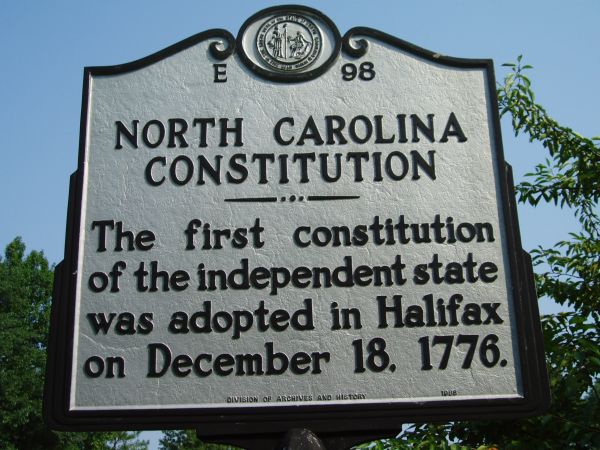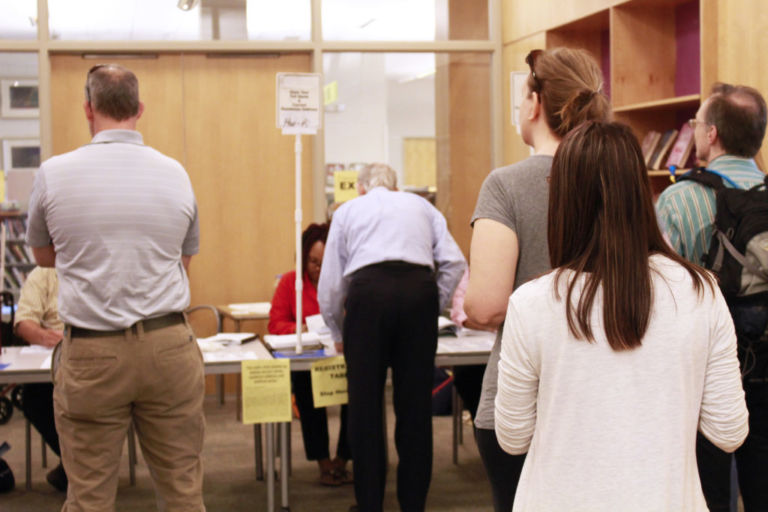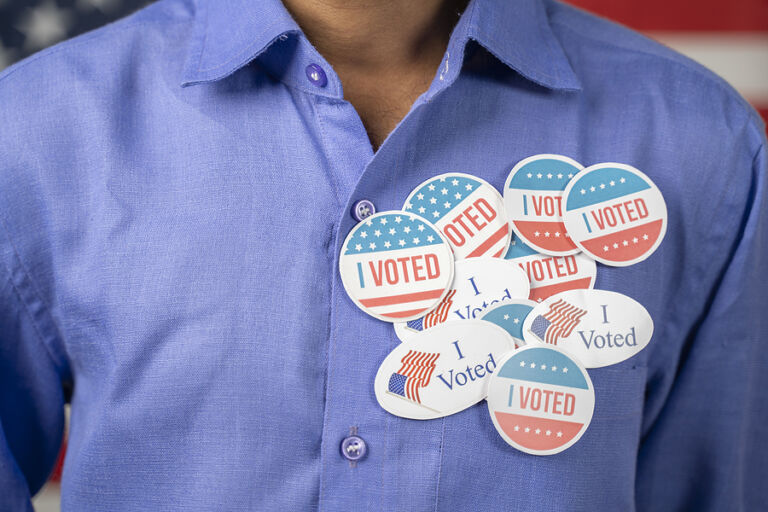- A loophole in North Carolina law allows ballots from unverified registrations to be counted
- About 1,760 ballots from never verified voter registrations were counted in the 2020 election alone
- Ballots from unverified registrations should be made provisional, and affected registrants should be given an opportunity to verify their registrations
A loophole in North Carolina election law causes county election boards to accept ballots from individuals even though the boards could not verify their voter registrations. Over 1,700 such “ghost voters” (defined here as people who cast ballots despite not existing on voter rolls) cast ballots in the 2020 election. In that election, just 401 votes decided the North Carolina Supreme Court Chief Justice race.
Discovering the Existence of the “Ghost Voter” Problem
North Carolina allows same-day registration (SDR) during early voting.
The North Carolina “Notice to Same-Day Registrants” (those who register to vote during early voting) contains the following:
In the event the county board of elections cannot verify your address, your voter registration application will be denied and your absentee vote may be subject to challenge.
Those two sentences describe a situation in which someone registers to vote, claiming to live at a particular address. The county board of elections cannot verify that the person lives at that address, but the board still accepts the ballot from that unverified registration. The only thing that might prevent the ballot from that unverified registration from being counted is that it “may be subject to challenge.”
As we will see below, the threat of a challenge is empty. Nothing in current law or practice requires verification of SDR registrations before the associated ballots are counted.
“Voters” included “several young men who came from out of state to attend a basketball program.”
Nor is this a new problem. The Civitas Institute conducted a study in 2008 in which letters were sent to regular and same-day registrants before the 2008 primary. The study found that mailings to SDR addresses were returned as undeliverable at “more than twice the rate of those who registered during the normal registration process.” Some of those undeliverable addresses included closed businesses and empty lots. The Voter Integrity Projected pointed out a decade ago that “nothing in SDR law effectively prevents fraud.”
Right on cue, two candidates in a 2013 local election in Robeson County exploited SDR to get ineligible people to register and vote:
Some of those people, including several young men who came from out of state to attend a basketball program, managed to cast ballots because they were mistakenly registered during one-stop absentee voting.
It is unknown whether those candidates’ exploits were unusual or just unartful enough to be caught.
The North Carolina State Board of Elections (SBE) has long been aware of the problem. They warned county election boards in a 2016 memo that they had to work to address the problem:
The State Board of Elections is keenly aware that a number of same-day registrants fail mail verification after the county has completed its canvass. It is imperative that counties work diligently to issue verification mailings and log returned mail throughout the one-stop early voting period. [Emphasis in the original]
Still, the loophole persists.
Discovering the Extent of the Ghost Voter Problem
I tried to discover the extent of the ghost voter problem as part of a report on the 2020 election. I filed a public records request with the SBE on July 21, 2021 (Request 21-91) and received a reply on Aug. 12, 2021.
The SBE could not answer my question at that time about how many same-day registrations in the 2020 general election were not verified through a verification mailing. That is because the data “was published Dec. 9, and thus reflect voters’ registration statuses at that time” rather than on election day.
Their answer to my other question was concerning:
How many ballots were not counted as a result of addresses not being verified by a verification mailing?
We would expect this number to be 0, because voter challenges are not allowed without individualized knowledge within 90 days of a federal election, and returned mail does not constitute individualized evidence.
So, there was evidence that unchallengeable ghost voters existed, but the extent of that problem remained unknown.
I made another public records request on May 27, 2022 (Request 22-165) that again asked for the number of same-day registrations in the 2020 general election that were not verified through a verification mailing.
The SBE replied on Mar. 2, 2023. This time they had an answer to the question: about 1,760.
(The actual number may be slightly less because a tiny fraction of people who register during early voting do not vote on the same day.)
Here is the list of those 1,760 unverified registrations provided by the SBE, listed by county. They are in the “Unverified SDRs” column.
Unverified Same-Day Registrations (SDRs) and New Voter Registrations in the 2020 Election, By County
| County | Total SDRs | Unverified SDRs | New Non-SDRs | Unverified New Non-SDRs |
|---|---|---|---|---|
| ALAMANCE | 1,405 | 22 | 15,233 | 160 |
| ALEXANDER | 425 | 3 | 2,499 | 9 |
| ALLEGHANY | 103 | 0 | 819 | 0 |
| ANSON | 46 | 0 | 1,339 | 1 |
| ASHE | 114 | 0 | 2,119 | 9 |
| AVERY | 175 | 18 | 1,309 | 34 |
| BEAUFORT | 501 | 15 | 3,188 | 29 |
| BERTIE | 147 | 6 | 1,050 | 18 |
| BLADEN | 228 | 17 | 2,057 | 25 |
| BRUNSWICK | 1,217 | 21 | 15,077 | 91 |
| BUNCOMBE | 2,903 | 86 | 23,772 | 246 |
| BURKE | 765 | 35 | 6,582 | 59 |
| CABARRUS | 2,156 | 27 | 22,085 | 145 |
| CALDWELL | 1,016 | 13 | 6,357 | 30 |
| CAMDEN | 87 | 0 | 940 | 1 |
| CARTERET | 415 | 18 | 6,607 | 56 |
| CASWELL | 196 | 2 | 1,629 | 7 |
| CATAWBA | 1,292 | 20 | 13,082 | 124 |
| CHATHAM | 758 | 19 | 6,867 | 24 |
| CHEROKEE | 242 | 2 | 2,102 | 17 |
| CHOWAN | 88 | 0 | 1,021 | 0 |
| CLAY | 86 | 1 | 899 | 7 |
| CLEVELAND | 1,220 | 28 | 7,905 | 79 |
| COLUMBUS | 475 | 14 | 3,514 | 53 |
| CRAVEN | 744 | 19 | 8,653 | 123 |
| CUMBERLAND | 4,313 | 97 | 30,036 | 379 |
| CURRITUCK | 193 | 0 | 2,813 | 6 |
| DARE | 364 | 2 | 3,976 | 54 |
| DAVIDSON | 1,678 | 29 | 13,849 | 142 |
| DAVIE | 381 | 11 | 3,535 | 17 |
| DUPLIN | 97 | 0 | 2,979 | 23 |
| DURHAM | 3,770 | 97 | 34,434 | 426 |
| EDGECOMBE | 727 | 2 | 3,073 | 24 |
| FORSYTH | 2,712 | 23 | 30,770 | 241 |
| FRANKLIN | 937 | 19 | 6,703 | 56 |
| GASTON | 2,075 | 0 | 20,077 | 0 |
| GATES | 100 | 0 | 706 | 6 |
| GRAHAM | 51 | 0 | 545 | 5 |
| GRANVILLE | 500 | 6 | 4,919 | 32 |
| GREENE | 218 | 5 | 1,036 | 13 |
| GUILFORD | 4,675 | 127 | 43,105 | 704 |
| HALIFAX | 627 | 0 | 2,533 | 0 |
| HARNETT | 1,765 | 41 | 12,530 | 124 |
| HAYWOOD | 596 | 0 | 5,296 | 12 |
| HENDERSON | 1,053 | 3 | 9,798 | 35 |
| HERTFORD | 199 | 6 | 1,266 | 22 |
| HOKE | 634 | 6 | 5,107 | 32 |
| HYDE | 27 | 0 | 308 | 3 |
| IREDELL | 1,660 | 1 | 18,105 | 7 |
| JACKSON | 1,099 | 68 | 3,951 | 110 |
| JOHNSTON | 2,322 | 40 | 20,198 | 133 |
| JONES | 86 | 0 | 806 | 0 |
| LEE | 644 | 4 | 4,912 | 26 |
| LENOIR | 695 | 13 | 3,611 | 43 |
| LINCOLN | 1,117 | 21 | 8,478 | 64 |
| MACON | 226 | 2 | 2,770 | 29 |
| MADISON | 283 | 22 | 1,781 | 27 |
| MARTIN | 232 | 5 | 1,308 | 12 |
| MCDOWELL | 487 | 22 | 3,318 | 36 |
| MECKLENBURG | 7,910 | 114 | 94,387 | 924 |
| MITCHELL | 211 | 1 | 1,188 | 9 |
| MONTGOMERY | 257 | 16 | 1,899 | 26 |
| MOORE | 1,079 | 2 | 8,427 | 23 |
| NASH | 1,208 | 35 | 6,779 | 116 |
| NEW HANOVER | 2,072 | 113 | 22,859 | 365 |
| NORTHAMPTON | 155 | 7 | 1,095 | 15 |
| ONSLOW | 1,861 | 67 | 17,433 | 331 |
| ORANGE | 1,146 | 14 | 15,090 | 380 |
| PAMLICO | 114 | 1 | 1,066 | 9 |
| PASQUOTANK | 190 | 0 | 3,138 | 7 |
| PENDER | 791 | 14 | 6,247 | 38 |
| PERQUIMANS | 186 | 0 | 1,389 | 0 |
| PERSON | 455 | 9 | 2,944 | 13 |
| PITT | 1,723 | 66 | 13,863 | 345 |
| POLK | 187 | 1 | 1,787 | 18 |
| RANDOLPH | 1,342 | 17 | 10,468 | 41 |
| RICHMOND | 427 | 9 | 2,554 | 52 |
| ROBESON | 1,060 | 0 | 7,289 | 176 |
| ROCKINGHAM | 114 | 2 | 6,321 | 45 |
| ROWAN | 1,268 | 17 | 11,765 | 77 |
| RUTHERFORD | 524 | 28 | 4,118 | 61 |
| SAMPSON | 719 | 0 | 3,486 | 12 |
| SCOTLAND | 366 | 14 | 2,214 | 24 |
| STANLY | 529 | 13 | 4,270 | 43 |
| STOKES | 307 | 0 | 3,635 | 6 |
| SURRY | 756 | 7 | 4,960 | 17 |
| SWAIN | 143 | 8 | 1,036 | 21 |
| TRANSYLVANIA | 286 | 0 | 2,534 | 0 |
| TYRRELL | 18 | 0 | 206 | 0 |
| UNION | 1,678 | 0 | 21,688 | 9 |
| VANCE | 439 | 23 | 2,775 | 44 |
| WAKE | 9,673 | 28 | 96,599 | 659 |
| WARREN | 238 | 5 | 1,200 | 18 |
| WASHINGTON | 79 | 5 | 687 | 9 |
| WATAUGA | 981 | 20 | 6,454 | 72 |
| WAYNE | 1,424 | 30 | 7,551 | 61 |
| WILKES | 480 | 11 | 4,743 | 38 |
| WILSON | 463 | 3 | 5,325 | 62 |
| YADKIN | 291 | 2 | 2,789 | 15 |
| YANCEY | 205 | 0 | 1,225 | 6 |
| Totals | 96,702 | 1,760 | 880,820 | 8,377 |
As seen in those data, the unverified rate for SDRs (1.82%) is almost twice as high as the unverified rate for non-SDR new registrations (0.95%). That finding is consistent with the results of the 2008 Civitas Institute study cited above.
Discovering a Solution to the Ghost Voter Problem
The SBE, in their answer to my second public records request, stated why they believe county election boards should accept ballots from unverified SDRs:
When a person same-day registers, unlike through ordinary means of registration, they must provide proof of residency—an approved document showing the voter’s name and current address …. It is at that point that their address is confirmed for the purpose of same-day registration.
So we have a conflict between evidence that someone registering to vote lived at an address a few weeks or years ago and evidence that the same person did not live at that address at the time of the election.
How do we resolve that conflict?
If we are going to have same-day registration, a solution to the unverified registration loophole is to make ballots associated with SDRs that are unverified on election day provisional. Provisional ballots are a stopgap measure election officials use when there are questions about whether or not someone is legally eligible to vote. Those ballots are set aside until officials can determine the person’s eligibility.
The unverified SDR ballots should remain provisional until either the registration is verified through normal means or the registrant otherwise confirms his or her address with the county board of elections in time for the county canvas (when the board certifies the election). Ballots from SDRs that remain unverified by the time of the county canvas would not be counted.
SDR period ends three days before election day. The county canvas is ten days after election day. That would give the county board at least 13 days to verify SDRs. If election officials cannot verify SDRs within that timeframe, the General Assembly should change the SDR deadline to give them the time they need to perform that verification.
The General Assembly should close the unverified registration loophole that allowed 1,760 ghost voters to cast ballots in 2020.


